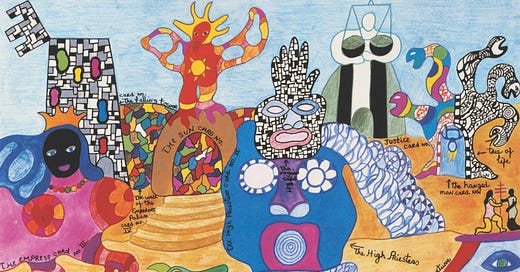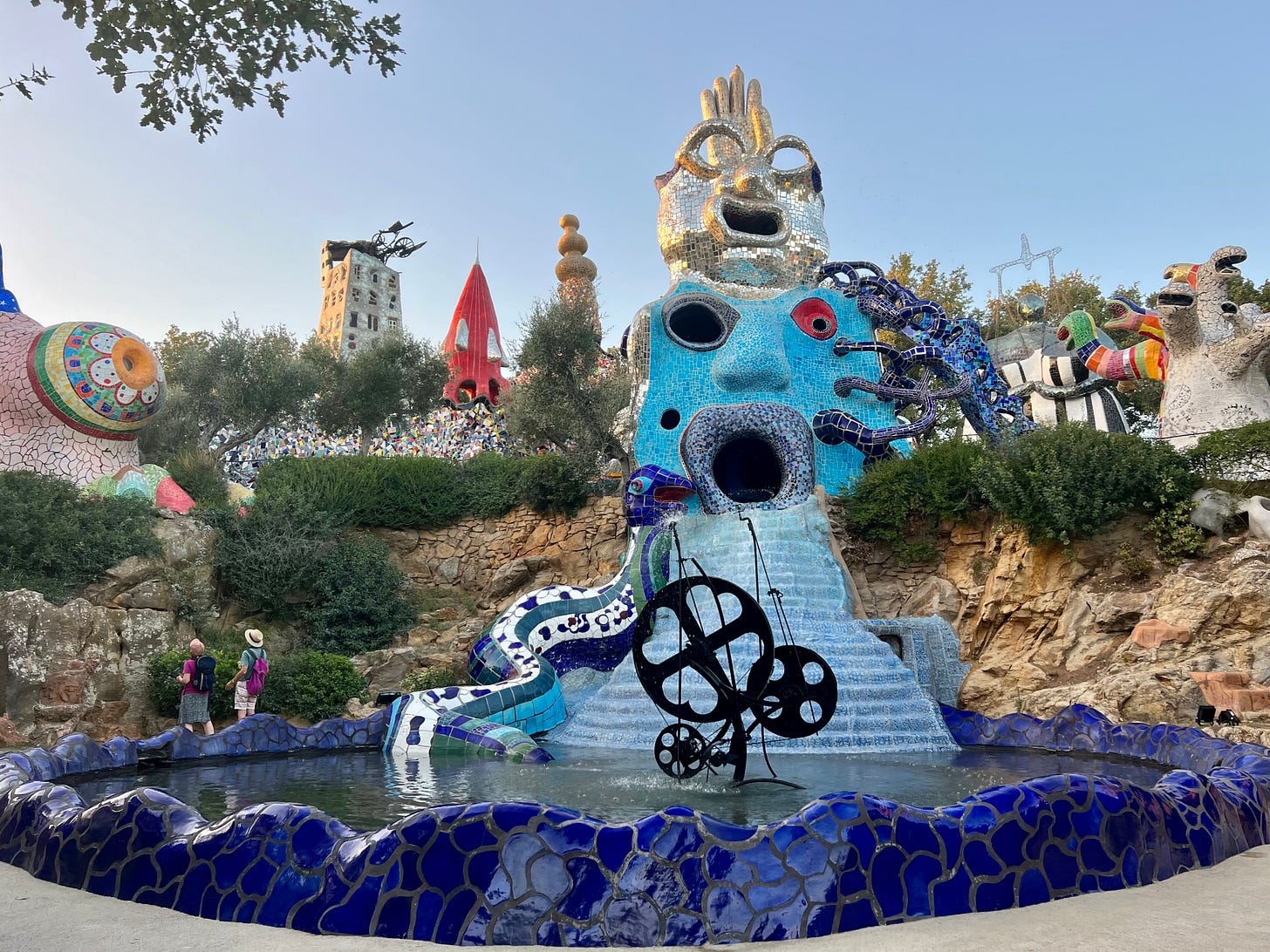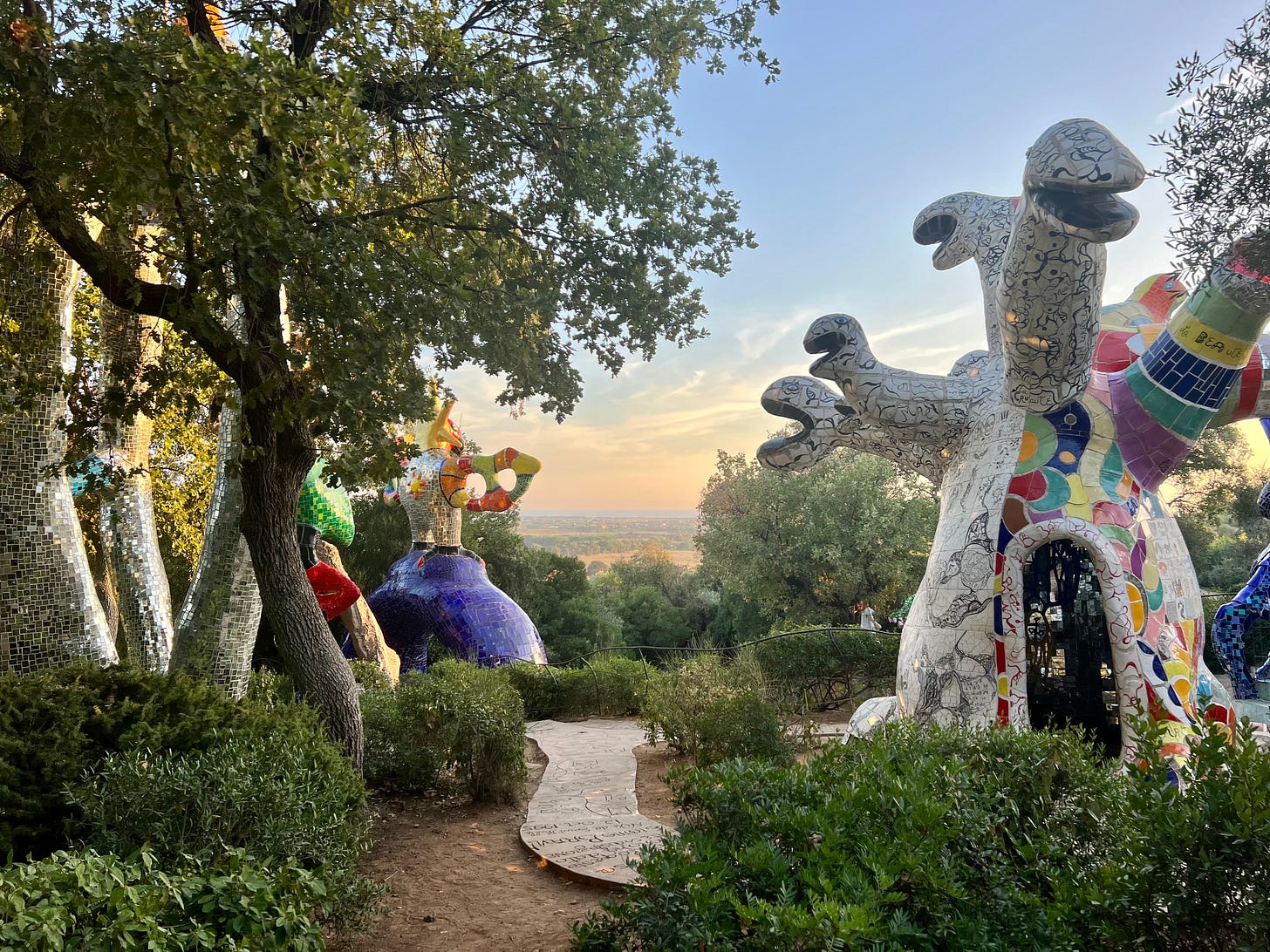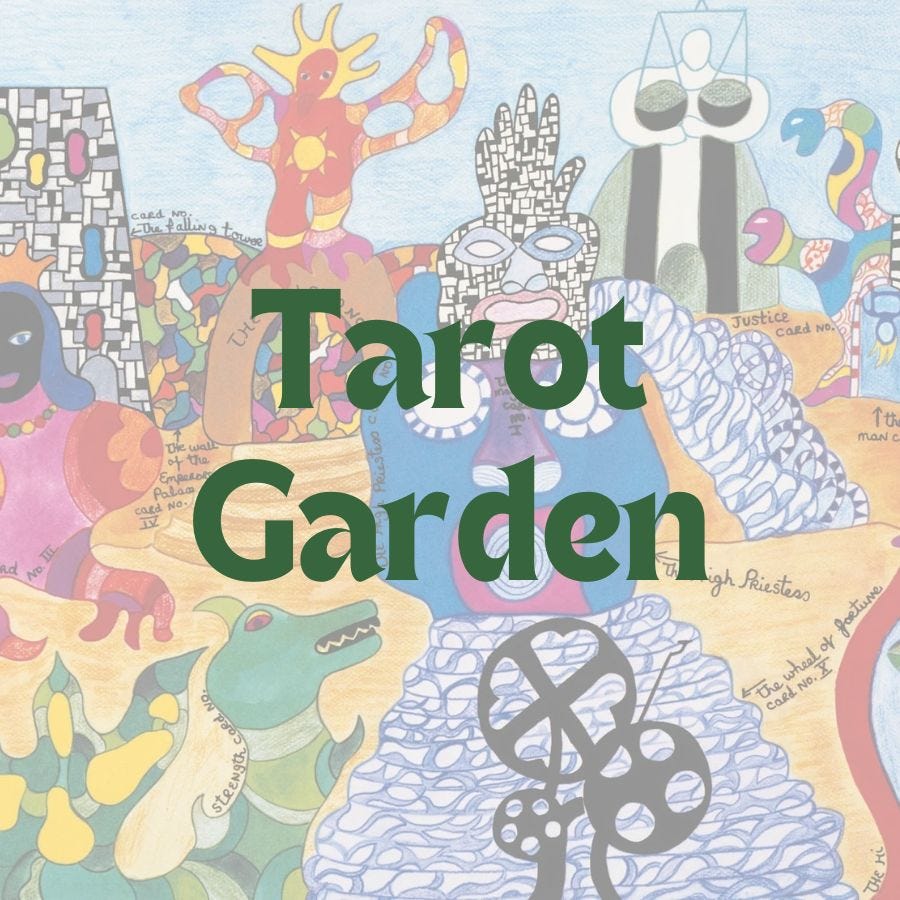Above the sun-baked hills of grapevines and olive groves is an immersive psychedelic wonder tucked away in the Tuscan countryside. A colossal work of art that took twenty years and more than a village to bring to life, Il Giardino dei Tarocchi, or the Tarot Garden, is the wondrous magnum opus of Franco-American artist Niki de Saint Phalle. The twenty-two figures of the Tarot’s Major Arcana are represented as kaleidoscopically hued and patterned sculptures, some rising 50 feet from the ground. The Magician is stacked on top of The Emperor, a sight you first encounter from below, and it is just enormous. The Hanged Man dangles inside the Tree of Life that has snakes for branches, a found object Jean Tinguely sculpture spills from the top of The Fallen Tower, and The Fool regularly changes location throughout the garden, portraying a journey’s new beginning, ready to discover. Each sculpture is embellished in an abundance of colorful mosaics and shimmering mirrors that sometimes blind you as they reflect the sun above. I had first learned about the Tarot Garden years ago and every friend who spent an afternoon there talked about it with such fervor, there was no question that I needed to experience it myself.
Friday, October 13th felt like a perfectly auspicious day for me to make the pilgrimage to Niki’s Tarot Garden. Despite the garden being only reachable by car, I was and will likely always be terrified to attempt driving in Italy, so I took the train from Rome to the small village of Capalbio. The Internet said catching a cab to the garden wouldn’t be a problem, but that was a lie. After a half hour of trying unsuccessfully to reach the numbers listed on the side of a bus shelter, I walked into the train station trattoria and somehow managed enough terribly broken Italian to convince the bartender to call what turned out to be the lone taxi driver in the village.
Only once I was physically in the car (that wasn’t a taxi) with a stranger, a severe language barrier between us, speeding down the road, did I realize what a ridiculous decision I had just made as a single woman traveling alone. I remained hopeful while still envisioning myself escaping the car and running down the highway in the Italian countryside, relying on my International data plan and Google Maps to get me where I needed to go. Nonetheless, the ride was over in less than ten minutes and quickly forgotten about as I walked through the gates and up the hill to the garden. It was even more spectacular than I had ever imagined it to be.
I was completely awe-struck upon first seeking the bizarre collection of larger-than-life monsters, goddesses, and architecture rising from the earth. An endless array of mosaics and mirrors everywhere I looked, with a fountain holding a motorized sculpture sitting in the water just before me. A glittering green dragon just to my left, the imposing presence of a sphinx-like Empress holding court, a multilevel tower and rocket ship in one direction, a ginormous bird perched atop a towering arch in the other. And this fantastical creature covered in blues, white, and silver sitting dead center, spewing water down to the fountain at my feet. It was a lot to take in. My mouth was agape and I wasn’t sure where to even begin exploring. I wanted to absorb every last detail of the garden, to slowly inch my way through. But I was also just so energized to actually be there, I had to fight my urge to see twelve things at once.
In the three hours I spent at the Tarot Garden, I made countless laps around the place, walking a path this way and that, approaching sculptures from all sides to see how they appeared from different perspectives, sitting on a bench or tucking myself away in a cavern, standing atop a walkway and watching the light change upon a decorated surface. The natural flora of the region seamlessly nestles itself against each sculpture, engaging in a dialogue between abstract cartoonish aesthetics and the natural world. While the largest pieces are gathered in the center of the garden, smaller sculptures dot the surrounding landscape, some easily discovered, others found down quiet paths, hidden by a circle of olive trees and shrubs. It’s a wonderful balance between feeling overpowered by the scale and energy of a massive structure and then encountering introspective spaces that encourage contemplation. Months later, I’m still celebrating Niki’s ability to create a dazzling oasis that allows adults to reclaim their childlike wonder while at the same time tapping into emotional depths as they gaze upon mosaics.
The idea for the Tarot Garden came to Niki in a dream while she was in an asylum after suffering a mental breakdown in her early twenties. She found her penchant for creativity during that time and is quoted as saying, “My mental breakdown was good in the long run, because I left the clinic a painter.” Niki made a name for herself in the early 1960s as the beautiful woman who fired rifles at sculptural paintings of emblems of domesticity, hitting hidden reservoirs of paint that then dripped down over the surface. It was performance art before such a thing could even be categorized as performance art. An icon of Niki’s oeuvre are her many Nanas: a massive collection of voluptuous, buoyant sculptures that exuberantly dance in a riot of color. Some fit on a small pedestal, others skip across plazas as public art, a reclined one was called Hon and took up an entire room, creating a stir in 1966 Stockholm as visitors entered and exited the sculpture through the birth canal. Niki later bragged in a letter to a friend that “a Stockholm psychiatrist wrote in the newspaper that the Hon would change people’s dreams for years to come.”
Art had healed Niki, and as a result, she wanted to create a sprawling sculpture garden that would heal others. Mutating pain into something joyous, Niki set about designing her Tarot Garden. She had a transformative experience at Antoni Gaudí’s Park Güell in Barcelona in 1955 and wished to outdo Gaudí. Her garden would be weirder, wilder, and inspired by the mysticism of the tarot deck. Calling it “a sort of joyland where you could have a new life that would just be free,” Niki finally began work on the Tarot Garden in 1978.
And how exactly does an artist strike the good fortune of being gifted fourteen acres of land upon which to create their dream project? By being a former teen model who made a lasting friendship with another teen model who just so happened to be part of one of the oldest Neapolitan dynasties. By the late 1970s, Marella Agnelli was married to the president of Fiat and invited the likes of Truman Capote and John and Jackie Kennedy to sail on her yacht. After sharing her idea for the garden with Marella, the heiress proposed that Niki build her garden on an estate owned by her brothers near the medieval village of Capalbio. And just like that, Niki was gifted the space to make her art — atop an Etruscan ruin no less — and would be protected by Italian nobility throughout the process.
With plans to build twenty-two sculptures, some as large as a house, Niki employed a massive team of professionals from Italy and abroad, as well as locals with little experience to help bring her vision to life. Each sculpture was constructed on site, and given that this was an entirely outdoor project, they needed to withstand long-term weathering from sun and rain. Her husband, Jean Tinguely, and a band of Swiss ironworkers welded iron armatures for each structure using layers of steel rebar and expanding metal followed by casting mesh. Shotcrete was sprayed over the steel followed by a layer of tar for waterproofing and finally white cement, leaving a blank canvas for decoration.
A Roman ceramicist, Verena Finocchiaro, taught the local women a myriad of techniques, from glazing variations and glasswork to molding ceramic pieces to curved surfaces. The women produce a mountain of elaborate tilework that covers each sculpture, including a segment of The Empress dominated by lace detailing, created by pressing the women’s marriage quilts into unbaked clay tiles. The tiles were then glazed in milky shades of salmon and rose that contrast beautifully with The Empress’s deep blue mirrored hair. Italian journalist Marella Caracciolo Chia noted the positive effects of Niki’s project: “These women who were from very simple backgrounds — suddenly just by working for her and being part of this project — started walking differently, wearing different clothes.”
The local postman, Ugo Celletti, started working at the Tarot Garden in 1979, staying on for 36 years until his passing, and recruiting his nephews in the process. First laying stone paths throughout the estate and securing wire mesh to the steel foundation of sculptures, Ugo then asked Niki if he could give mosaics a try. What resulted was a new passion for Ugo, and a lot of delayed mail for the local community. As the story goes, he would get so caught up in applying symphonies of mirrored glass that he’d forget about his postal route. Niki thought that was perfectly acceptable, calling him “a poet of putting on mirrors.”
Niki invited numerous friends from abroad to come to Tuscany and help build the Tarot Garden in partnership with the villagers. Artists from France, Scotland, Holland, and Argentina arrived, further changed the texture of daily life in Capalbio. In 1983, Niki moved into The Empress where she would live and work for the next seven years. The entire interior is a riot of mirrors with nearly every surface covered, reflecting and refracting light throughout the space. It is unlike any home I have ever stepped inside. Designed in the shape of a womanly sphinx, Niki’s bedroom was held within one breast, while her kitchen sat in the other. Within the torso of The Empress is a fireplace, a handful of round windows looking out at the surrounding landscape, and a long mirrored dining table. Each afternoon, Niki would cook and serve lunch inside The Empress, creating a warm communal tradition that carried on for years. After two decades of intense labor characterized by painful mishaps and joyous discoveries, the Tarot Garden officially opened to the public on May 15, 1998.
I think it’s important to point out that Niki didn’t want to be reliant on a patron or the gallery system, so she figured out a way to fund her projects without those. The 1960s art world was scandalized when she mass produced inflatable Nana balloons marketed as spirited pool/beach toys. (They’re still for sale, with all proceeds helping support the Tarot Garden and its conservation.) The scrutiny didn’t matter to her. Her projects were monumental in scale and needed serious amounts of cash to make happen. Adjusting for inflation, the Tarot Garden cost eleven million dollars to complete. Niki managed to secure a third of the funding for the garden by creating a perfume, packaged in a vibrant cobalt blue glass bottle with a pair of three-dimensional intertwined snakes rising vertically from the gold stopper. Andy Warhol, king of artistic mass-production, attended the launch party.
Niki saw being her own benefactor as a feminist act with many advantages: she was free from needing to cater to patrons and could work within her own illogical timeline. I love that she sought to build a healing space overflowing with joy and possibility, and did it on her own terms every step of the way. There’s a story that Gloria Steinem once saw Niki strolling down the street in New York sans purse, wearing a cowboy getup, and thought, “That is the first free woman I have ever seen in real life. I want to be just like her.” Niki envisioned new approaches towards life as a woman, exercising her own set of feminist beliefs within her personal life just as much as through the artwork she created.
The cherry on top to my Tarot Garden visit was the ecstatic joy of getting to experience the place at sunset. An hour before closing, the garden emptied out and it was just me and a handful of others. First, it’s thrilling to have public spaces almost entirely to yourself. Second, I was not prepared for how ridiculously gorgeous the Tarot Garden would become basking in the afterglow of a Tuscan sunset. No adjective will properly describe the beauty of witnessing soft evening light bounce off thousands of tiny mirrors. After wandering the grounds once more, I stood on the walkway atop The Emperor to say my goodbyes to the garden before descending down the hill. A sea of black and white checked tiles beneath my feet, eccentric sculptures and picturesque Italian greenery in every direction, a warm wash of sky above and the valley below. I was breathing deeply, fully, with a stupid grin upon my face. I was filled with immense gratitude to Niki for following through on a dream, for working so hard to create a space for others to find inspiration.
Most of what I know about tarot I’ve learned from this excursion and seeking out information afterwards. For me, the exquisite takeaway is that tarot cards are not actually foretelling the future, but rather using imagery and storytelling to plant seeds in the subconscious. They function as collaborative guides that ask you to question, reflect, and dream. An expansive use of one’s imagination and conversations with friends are encouraged. They’re exploratory and open ended, allowing you to more deeply understand yourself and the path you’re on. It’s inspiring to have witnessed all of that translated into physical form within Niki’s Tarot Garden. The essence of tarot was present throughout the process of building the garden with a wide crew of helpers, and it persists in the experience of exploring the grounds as a visitor. Over the course of her career, Niki channeled her pain, anger, and frustration into making art centered in optimism, pleasure, and ecstatic joy. As she said herself, “people refuse to realize that joy is something terribly serious.” Amen Niki, amen.
Given the ubiquity of mirrors in Niki’s work, it felt fitting to put together a playlist overflowing in disco-adjacent vibes. Put it on, maybe pull a tarot card, and dance with glee.
— Katie













